
Concept explainers
(a)
Interpretation:
The explanation for alanine which has different optical rotation in water,
Concept introduction:
The amino acid is made of two
Answer to Problem 27.61AP
Each solvent rotates the alanine molecule to a different angle due to the formation of different complex formation and so it gives rise to different optical rotation in different solvents.
Explanation of Solution
The structure of alanine is shown below.
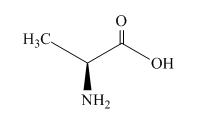
Figure 1
Alanine is an optically active compound. It rotates the plane of polarized light. The reaction of alanine with water,
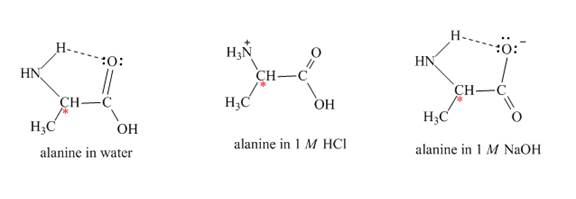
Figure 2
The optical rotation of alanine is measure by Circular Dichroism (CD). It involves circularly polarized light absorption. It measures the angle at which the plane-polarized light is rotated by the molecule. Each solvent rotates the alanine molecule to a different angle, due to this it gives rise to different optical rotation in different solvents.
The alanine has different optical rotation in water,
(b)
Interpretation:
The explanation for two known mono
Concept introduction:
The amino acid is made of two functional groups an amine group,
Answer to Problem 27.61AP
Due to the presence of two amine groups in lysine molecule. It may undergo acetylation reaction from either side and form mono
Explanation of Solution
The structure of amino acid lysine is shown below.
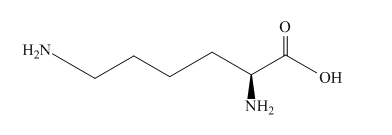
Figure 3
The structure of the lysine molecule contains two amine group one at the
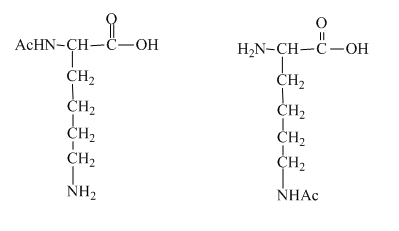
Figure 4
The two mono
(c)
Interpretation:
The explanation for fact that the peptide
Concept introduction:
The amino acid is made of two functional groups an amine group
Answer to Problem 27.61AP
The compound urea under basic conditions acts as a denaturation agent which breakdown the protein molecule bonding. Due to this, the peptide,
Explanation of Solution
The protein molecule is composed of four types of structure primary, secondary, tertiary and quarternary. The enzyme trypsin hydrolyzes the peptide,
The peptide
(d)
Interpretation:
The explanation for the peptide containing cysteine on reaction with
Concept introduction:
The amino acid is made of two functional groups an amine group,
Answer to Problem 27.61AP
The generation of lysine type molecule at the end of the reaction which is cleaved by trypsin enzyme. Due to this, the peptide containing cysteine on reaction with
Explanation of Solution
The structure of the cysteine molecule is shown below.
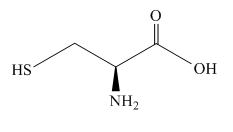
Figure 5
The same molecule in peptides exists as a disulfide bond. The disulfide bond of cysteine in the protein molecule is shown below.
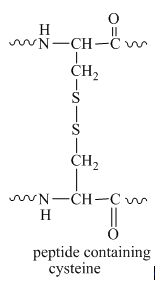
Figure 6
When this protein molecule with a disulfide bond is treated with
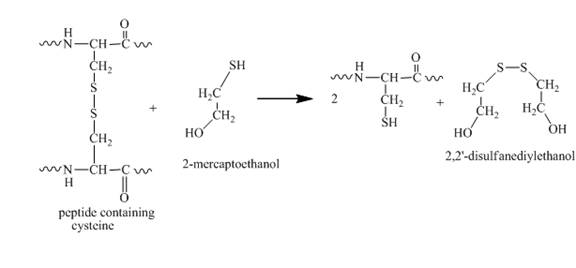
Figure 7
The thiol group is then reacted with the aziridine molecule which results in the formation of a lysine type molecule. This reaction is shown below.
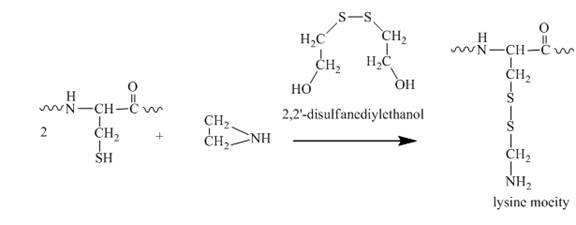
Figure 8
This lysine type molecule then reacts with trypsin enzyme which cleaves arginine and lysine molecule. Due to this, the trypsin enzyme reacts with the modified cysteine residues.
The peptide containing cysteine on reaction with
(e)
Interpretation:
The explanation for the formation of two separable methionine sulfoxides from the oxidation of
Concept introduction:
The amino acid is made of two functional groups an amine group,
Answer to Problem 27.61AP
The application of a certain amount of energy which converts one form to another form of structure. Due to this, the formation of two separable methionine sulfoxides from the oxidation of
Explanation of Solution
The structure of methionine is shown below.
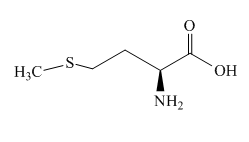
Figure 9
The resonance structure of sulfoxides with two different groups is shown below.

Figure 10
The conversion of one structure to another structure at room temperature requires a certain amount of energy. Therefore, on the application of that amount of energy, the two forms of
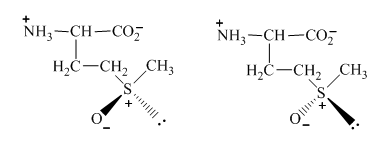
Figure 11
The formation of two separable methionine sulfoxides from the oxidation of
Want to see more full solutions like this?
Chapter 27 Solutions
EBK ORGANIC CHEMISTRY STUDY GUIDE AND S
- An open vessel containing water stands in a laboratory measuring 5.0 m x 5.0 m x 3.0 m at 25 °C ; the vapor pressure (vp) of water at this temperature is 3.2 kPa. When the system has come to equilibrium, what mass of water will be found in the air if there is no ventilation? Repeat the calculation for open vessels containing benzene (vp = 13.1 kPa) and mercury (vp = 0.23 Pa)arrow_forwardEvery chemist knows to ‘add acid to water with constant stirring’ when diluting a concentrated acid in order to keep the solution from spewing boiling acid all over the place. Explain how this one fact is enough to prove that strong acids and water do not form ideal solutions.arrow_forwardThe predominant components of our atmosphere are N₂, O₂, and Ar in the following mole fractions: χN2 = 0.780, χO2 = 0.21, χAr = 0.01. Assuming that these molecules act as ideal gases, calculate ΔGmix, ΔSmix, and ΔHmix when the total pressure is 1 bar and the temperature is 300 K.arrow_forward
- dG = Vdp - SdT + μA dnA + μB dnB + ... so that under constant pressure and temperature conditions, the chemical potential of a component is the rate of change of the Gibbs energy of the system with respect to changing composition, μJ = (∂G / ∂nJ)p,T,n' Using first principles prove that under conditions of constant volume and temperature, the chemical potential is a measure of the partial molar Helmholtz energy (μJ = (∂A / ∂nJ)V,T,n')arrow_forwardThe vapor pressure of dichloromethane at 20.0 °C is 58.0 kPa and its enthalpy of vaporization is 32.7 kJ/mol. Estimate the temperature at which its vapor pressure is 66.0 kPa.arrow_forwardDraw the structure of A, the minor E1 product of the reaction. Cl Skip Part Check F1 esc CH_CH OH, D 3 2 Click and drag to start drawing a structure. 80 R3 F4 F2 F3 @ 2 # $ 4 3 Q W 95 % KO 5 F6 A F7 × G ☐ Save For Later Sub 2025 McGraw Hill LLC. All Rights Reserved. Terms of Use | Privacy C ►II A A F8 F9 F10 FL 6 7 88 & * 8 9 LLI E R T Y U A S D lock LL F G H 0 P J K L Z X C V B N M 9 Harrow_forward
- From the choices given, which two substances have the same crystal structure? (Select both) Group of answer choices ZnS (zincblende) Diamond TiO2 (rutile) ZnS (wurtzite)arrow_forwardPotassium (K) blends with germanium (Ge) to form a Zintl phase with a chemical formula of K4Ge4. Which of the following elements would you expect potassium to blend with to form an alloy? Electronegativities: As (2.0), Cl (3.0), Ge (1.8), K (0.8), S (2.5), Ti (1.5) Group of answer choices Arsenic (As) Sulfur (S) Chlorine (Cl) Titanium (Ti)arrow_forwardConsider two elements, X and Z. Both have cubic-based unit cells with the same edge lengths. X has a bcc unit cell while Z has a fcc unit cell. Which of the following statements is TRUE? Group of answer choices Z has a larger density than X X has more particles in its unit cell than Z does X has a larger density than Z Z has a larger unit cell volume than Xarrow_forward
- How many particles does a face-centered cubic (fcc) unit cell contain? Group of answer choices 2 14 8 4arrow_forwardV Highlight all of the carbon atoms that have at least one beta (B) hydrogen, using red for one ẞ hydrogen, blue for two ẞ hydrogens, and green for three ẞ hydrogens. If none of the carbon atoms have ẞ hydrogens, check the box underneath the molecule. ED X None of the carbon atoms have ẞ hydrogens. Explanation esc 2 Check * F1 F2 1 2 80 # 3 Q W tab A caps lock shift fn control F3 N S option O 694 $ F4 F5 F6 005 % E R D F LL 6 olo 18 Ar B © 2025 McGraw Hill LLC. All Rights Reserved. Terms of Use | Privacy Center | Accessibility A DII F7 F8 87 & * 8 T Y U G H 4 F9 F10 ( 9 0 E F11 F12 உ J K L + || X C V B N M H H command option commandarrow_forwardConsider the reaction below and answer the following questions. Part 1 of 4 Br NaOCH2CH3 Identify the mechanisms involved. Check all that apply. SN 1 SN 2 E1 E2 None of the above Part 2 of 4 Skip Part Check esc F1 F2 lock 1 2 Q W A S #3 80 F3 F4 F5 F6 Save For © 2025 McGraw Hill LLC. All Rights Reserved. Terms ˇˇ % & 4 5 6 89 7 IK A 分 བ F7 F8 F9 F * E R T Y U 8 9 D F G H K V B N M 0 Oarrow_forward
 Chemistry: Principles and ReactionsChemistryISBN:9781305079373Author:William L. Masterton, Cecile N. HurleyPublisher:Cengage Learning
Chemistry: Principles and ReactionsChemistryISBN:9781305079373Author:William L. Masterton, Cecile N. HurleyPublisher:Cengage Learning Introduction to General, Organic and BiochemistryChemistryISBN:9781285869759Author:Frederick A. Bettelheim, William H. Brown, Mary K. Campbell, Shawn O. Farrell, Omar TorresPublisher:Cengage Learning
Introduction to General, Organic and BiochemistryChemistryISBN:9781285869759Author:Frederick A. Bettelheim, William H. Brown, Mary K. Campbell, Shawn O. Farrell, Omar TorresPublisher:Cengage Learning

